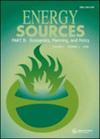评估立陶宛化学工业脱碳的可能性
IF 2.2
4区 工程技术
Q3 ENERGY & FUELS
Energy Sources Part B-Economics Planning and Policy
Pub Date : 2023-05-17
DOI:10.1080/15567249.2023.2214912
引用次数: 0
摘要
本文章由计算机程序翻译,如有差异,请以英文原文为准。
Assessment of decarbonization possibilities in Lithuania’s chemical industry
ABSTRACT The main objectives of this paper are to present the developed model and to explore and discuss the decarbonization possibilities of the Lithuanian chemical industry. The sector has high energy consumption and struggles to achieve emission reductions. The developed model is based on a bottom-up modeling approach representing the industry’s current and emerging technology mix. We conclude that the deep decarbonization of Lithuania’s chemical industry is technically feasible under certain conditions. The deployment of carbon capture technology is necessary to decrease carbon dioxide (CO2) emissions by at least 40% in 2030. To achieve deep decarbonization of the sector, green hydrogen as feedstock for ammonia production should be utilized before 2050. Decarbonization scenarios cause an increase of undiscounted costs by more than 618–3132 million Euros depending on CO2 reduction targets when cumulated over the 2018–2050 period. The ammonia production facility should cover a substantial share of these costs until 2030, which could negatively affect its competitiveness.
求助全文
通过发布文献求助,成功后即可免费获取论文全文。
去求助
来源期刊

Energy Sources Part B-Economics Planning and Policy
ENERGY & FUELS-
CiteScore
6.80
自引率
12.80%
发文量
42
审稿时长
6-12 weeks
期刊介绍:
12 issues per year
Abstracted and/or indexed in: Applied Science & Technology Index; API Abstracts/Literature; Automatic Subject Index Citation; BIOSIS Previews; Cabell’s Directory of Publishing Opportunities in Economics and Finance; Chemical Abstracts; CSA Aquatic Science & Fisheries Abstracts; CSA Environmental Sciences & Pollution Management Database; CSA Pollution Abstracts; Current Contents/Engineering, Technology & Applied Sciences; Directory of Industry Data Sources; Economic Abstracts; Electrical and Electronics Abstracts; Energy Information Abstracts; Energy Research Abstracts; Engineering Index Monthly; Environmental Abstracts; Environmental Periodicals Bibliography (EPB); International Abstracts in Operations Research; Operations/Research/Management Science Abstracts; Petroleum Abstracts; Physikalische Berichte; and Science Citation Index.
Taylor & Francis make every effort to ensure the accuracy of all the information (the "Content") contained in our publications. However, Taylor & Francis, our agents, and our licensors make no representations or warranties whatsoever as to the accuracy, completeness, or suitability for any purpose of the Content. Any opinions and views expressed in this publication are the opinions and views of the authors, and are not the views of or endorsed by Taylor & Francis. The accuracy of the Content should not be relied upon and should be independently verified with primary sources of information. Taylor & Francis shall not be liable for any losses, actions, claims, proceedings, demands, costs, expenses, damages, and other liabilities whatsoever or howsoever caused arising directly or indirectly in connection with, in relation to, or arising out of the use of the Content. Terms & Conditions of access and use can be found at http://www.tandfonline.com/page/terms-and-conditions .
 求助内容:
求助内容: 应助结果提醒方式:
应助结果提醒方式:


